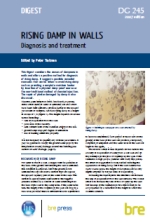Rising damp in walls - diagnosis and treatment (DG 245)
BRE (Building Research Establishment) is an independent, research-based consultancy, testing and training organisation, operating in the built environment and associated industries.
On 12 October 2007, BRE published Rising damp in walls - diagnosis and treatment (DG 245 revised edition), written by Peter Trotman.
Excess moisture is a common problem in buildings, and may be apparent from; damp patches, mould growth, mildew, salts, staining, ‘tide marks', blistering paint, bulging plaster and so on.
Rising damp is caused by capillary action drawing moisture up through porous elements of a building’s fabric. DG 245 considers the causes of rising damp in walls and how to remedy it if found.
Porous walls which stand in water or saturated soil without a damp proof course (dpc) can have rising damp to a height of more than 1m, with the height depending on:
- The rate of evaporation from the wall.
- The porosity of the wall.
- The salt content of the wall and soil.
- The groundwater height and saturation.
- Heating in the building.
Some accumulation of salts can occur in the walls of old buildings even when they do not have a damp problem, so high readings from a moisture meter alone are not conclusive. Appendix A of the 12-page digest describes how to drill samples from a wall in to test for moisture content and hygroscopicity, and the interpretation of moisture gradient profiles.
If a building has a physical damp-proof course (DPC), it is unlikely that it has failed, as most dpc materials have a long life, however, defects such as mortar droppings in a cavity wall, may make a dpc ineffective by bridging it and allowing moisture to pass up through the wall. This and other mechanisms by which an existing dpc might be bridged are discussed.
If it is necessary to provide a new moisture barrier, the digest explains methods such as; inserting a membrane or using chemical injection. The repair of plaster damaged by damp is also discussed.
The content of the digest includes:
- Mechanism of rising damp.
- Diagnosis.
- Determining the source of the dampness.
- Treatment.
- Replastering.
- Dry lining.
- Further reading.
- Appendix: The sampling method.
[edit] Related articles on Designing Buildings Wiki
- Assessing moisture in porous building materials.
- BRE articles on Designing Buildings Wiki.
- Building Research Establishment.
- Carbide meter.
- Condensation.
- Damp.
- Damp-proof course.
- Damp proof membrane.
- Defects in brickwork.
- Dew point.
- Diagnosing the causes of dampness (GR 5 revised).
- Does damp proofing work?
- Efflorescence.
- Electrical resistance meters.
- Interstitial condensation.
- Mould growth.
- Penetrating damp.
- Psychometric chart.
- Rising damp.
- Sling psychrometer.
- Spalling.
- Tanking.
- Treating brickwork with sealant or water repellent.
- Understanding dampness.
[edit] External references
Featured articles and news
Construction Skills Mission Board launch sector drive
Newly formed government and industry collaboration set strategy for recruiting an additional 100,000 construction workers a year.
New Architects Code comes into effect in September 2025
ARB Architects Code of Conduct and Practice available with ongoing consultation regarding guidance.
Welsh Skills Body (Medr) launches ambitious plan
The new skills body brings together funding and regulation of tertiary education and research for the devolved nation.
Paul Gandy FCIOB announced as next CIOB President
Former Tilbury Douglas CEO takes helm.
UK Infrastructure: A 10 Year Strategy. In brief with reactions
With the National Infrastructure and Service Transformation Authority (NISTA).
Ebenezer Howard: inventor of the garden city. Book review.
The Grenfell Tower fire, eight years on
A time to pause and reflect as Dubai tower block fire reported just before anniversary.
Airtightness Topic Guide BSRIA TG 27/2025
Explaining the basics of airtightness, what it is, why it's important, when it's required and how it's carried out.
Construction contract awards hit lowest point of 2025
Plummeting for second consecutive month, intensifying concerns for housing and infrastructure goals.
Understanding Mental Health in the Built Environment 2025
Examining the state of mental health in construction, shedding light on levels of stress, anxiety and depression.
The benefits of engaging with insulation manufacturers
When considering ground floor constructions.
Lighting Industry endorses Blueprint for Electrification
The Lighting Industry Association fully supports the ECA Blueprint as a timely, urgent call to action.
BSRIA Sentinel Clerk of Works Training Case Study
Strengthening expertise to enhance service delivery with integrated cutting-edge industry knowledge.
Impact report from the Supply Chain Sustainability School
Free sustainability skills, training and support delivered to thousands of UK companies to help cut carbon.
The Building Safety Forum at the Installershow 2025
With speakers confirmed for 24 June as part of Building Safety Week.
The UK’s largest air pollution campaign.
Future Homes Standard, now includes solar, but what else?
Will the new standard, due to in the Autumn, go far enough in terms of performance ?
BSRIA Briefing: Cleaner Air, Better tomorrow
A look back at issues relating to inside and outside air quality, discussed during the BSRIA briefing in 2023.
Restoring Abbotsford's hothouse
Bringing the writer Walter Scott's garden to life.
Reflections on the spending review with CIAT.




























Comments